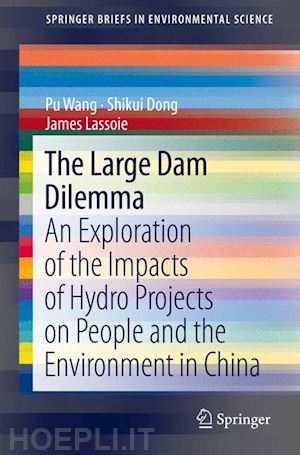
Questo prodotto usufruisce delle SPEDIZIONI GRATIS
selezionando l'opzione Corriere Veloce in fase di ordine.
Pagabile anche con Carta della cultura giovani e del merito, 18App Bonus Cultura e Carta del Docente
Large dam construction has significant environmental and social impacts at different scales. As the largest developing country in the world, China has built about half of the world’s large dams, and more are expected to be built over the next two decades to meet the country’s rapidly growing demand for energy. This book summarizes and updates information about the history, distribution, functions, and impacts of large dams, both globally and at China’s national level. It then addresses the environmental and social-economic impacts of large dams in China with particular emphasis on the impacts of large dams on relocated people and associated compensation policies. Lastly, it introduces an integrated ecological and socio-economic study conducted in areas affected by dams along the Upper Mekong River, China. This book has the following three goals.
The first goal is to summarize and update information on large dams globally and at China’s national level (Ch. 2). We examine large dam problems from different perspectives, ranging from their spatial and temporal distributions and their environmental and social impacts, to discussions and debates centered on them. We also incorporate the results of an empirical investigation of the environmental and socio-economic impacts of large dams on the Upper Mekong River, China, and draw conclusions out of the analysis (Chs.3 & 4).
Our second goal is to provide an analysis framework to help understand the environmental and social-economic impacts of dam construction and the resulting environmental degradations and social inequities at different scales (Chs.3 & 4), as well as to offer recommendations for mitigating these impacts within China’s socio-political context (Ch. 5). The significant environmental effects resulting from dam construction include damage to ecological integrity and loss of biological diversity. The most significant social consequences brought by dam projects are their negative impacts on relocated people. Our analysis framework provides approaches to help comprehensively understand these impacts.
Our third goal is to provide clues and suggestions for further studies of large dam problems both globally and in China (Ch. 5). The construction of large dams is proceeding rapidly in different parts of the world despite the heated debates on whether they should be built at all. The decision-making process related to building large dams involves considerations of economic viability, environmental sustainability, and social equity. Therefore, interdisciplinary collaborations are required in large dam research and development projects in order to reconcile the interests of different stakeholders and avoid harming ecosystems, biodiversity, and human welfare. Overall, we hope our book facilitates future examinations of large dams by providing summaries of existing data and research related to large dams, and offering a framework for better understanding and analyzing their environmental and social impacts.
Pu Wang is a doctoral student in the department of natural resources at Cornell University. He just completed a three-year project on large dams in Yunnan, China with Dr. Dong and Dr. Lassoie.
Dong Shikui is currently an India China Institute (ICI) Fellow at the New School in New York. He is a Professor at the School of Environment, Beijing Normal University. He was recently appointed an adjunct professor at Cornell University’s Natural Resource Department (2007-2012). He also serves as an “Invited Scientist” for the Environment Impact Assessment Center of China’s Ministry of Environmental Protection. Through the ICI Fellowship, he is interested in exploring ecological and social variables related to decision making in environmental management and best practices for sustainable, integrated ecosystems and environmental management.
Dr. James Lassoie is particularly interested in examining coupled human and natural systems involving the management of parks, protected areas, and otherwise fragile landscapes in developing countries as well as the United States. Lassoie pursues these interests often by working with graduate students, many from the countries under investigation. His primary focus for the next five years will be to examine coupled systems in the Hindu Kush-Himalayas, while further developing an Internet-based platform connecting conservation practitioners to academic research and teaching institutions (www.ConservationBridge.org).











Il sito utilizza cookie ed altri strumenti di tracciamento che raccolgono informazioni dal dispositivo dell’utente. Oltre ai cookie tecnici ed analitici aggregati, strettamente necessari per il funzionamento di questo sito web, previo consenso dell’utente possono essere installati cookie di profilazione e marketing e cookie dei social media. Cliccando su “Accetto tutti i cookie” saranno attivate tutte le categorie di cookie. Per accettare solo deterninate categorie di cookie, cliccare invece su “Impostazioni cookie”. Chiudendo il banner o continuando a navigare saranno installati solo cookie tecnici. Per maggiori dettagli, consultare la Cookie Policy.